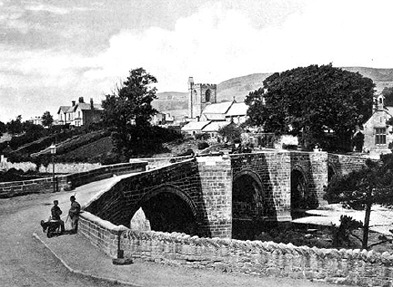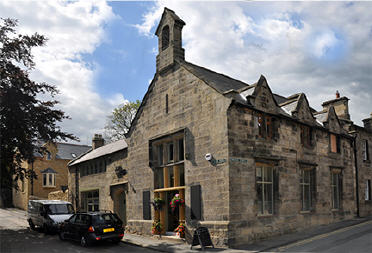|
The Bridge The bridge dates from the 15th
century.
Originally a three arch pack
horse bridge, the fourth arch was added in 1759 as the river grew wider:
the arch to the south of the river being the latest addition. The road became
more important as the corn road (the toll road) from Hexham and the Tyne Valley to the
port at Alnmouth. The old toll cottage lay a few hundred yards to the south, on
the road now leading to Hexham. The bridge was declared
unsatisfactory for modern traffic and the road was widened with the old
stone walls replaced by reinforced concrete. Today the bridge has been completely refurbished, in line with modern requirements and the stone parapets replaced. A great job by Northumberland County Council and taking almost three years. A temporary bridge had to be built and controlled by traffic lights and a one way system along Bridge Street and Haw Hill was installed whilst the work was being completed. This picture of the bridge is particularly interesting as not only does it show the original structure with passing places but also appears to show a gate house or tower just to the left of the church, and it is thought that this may be the only photograph of the remains of Rothbury Castle.
See if you can find the Mason marks underneath the stone arches. They are the marks of "that ancient and honourable institution" the masons guild and a personal trade-mark as symbol of their craft and lodge. The initials 'W O' may be seen on a lower course at the southern end. These initials were those of a local mason, William Oliphant, who worked on the bridge in 1759.
These marks sometimes
known as "Banker Marks" are widely seen across Europe from Roman
times to the present but most frequently on medieval work. These personal marks
were often passed from father to son and entered into the register of
Masonic
guild lodges. Before you cross the bridge look at the house at the end, formerly the blacksmith's shop, now privately owned. And see if you can spot the old pill box from the war years, guarding the frontier so to speak. Tucked away at the end of the bridge amongst the trees it is not al ways easy to see. Cross the Bridge to the
Boys School and note the belfry and large windows which
were a particular
feature of schools in this
area. Ita last use The school was originally built in 1841 for boys whilst the girl's school was just a few yards up the Toll Road at Hurley Knowes. Sometimes known as the Masonic hall, it has been converted to holiday cottages. If you follow the trail to the end you will return past the girls school. A quiet street today; who would have thought that Bridge street was once such a commercial area! Grocer and Drapers, Booksellers and Stationers, Game and Poultry Dealers, and Ironmongers, all plied their trade. There was even a Temperance Hotel, and at the southern most end of the bridge a Monumental Masons. Although businesses have changed or disappeared Bridge Street looks as it always did: apart from the ubiquitous yellow lines. From the Bridge turn left up Haw Hill towards the Parish church
|

